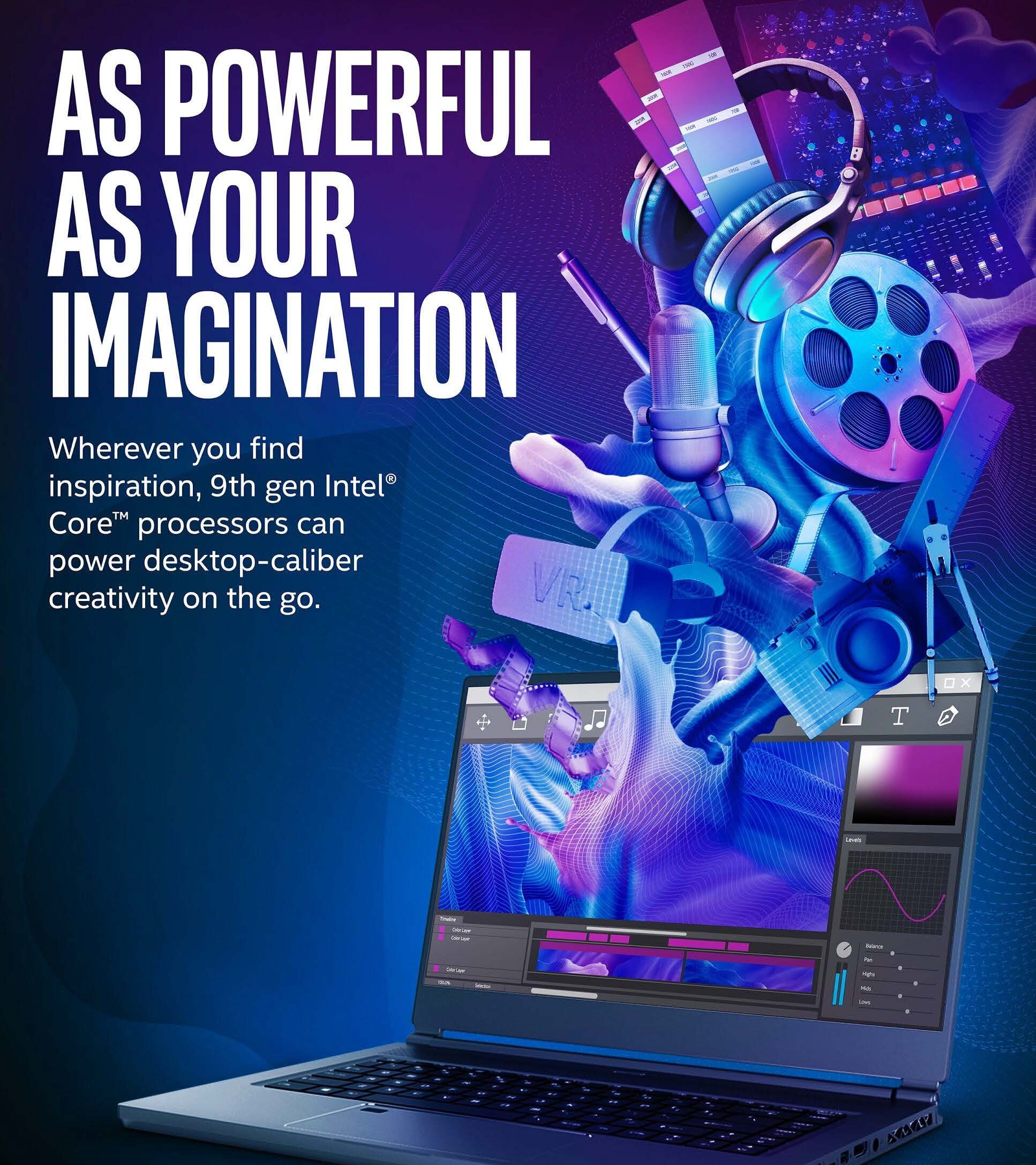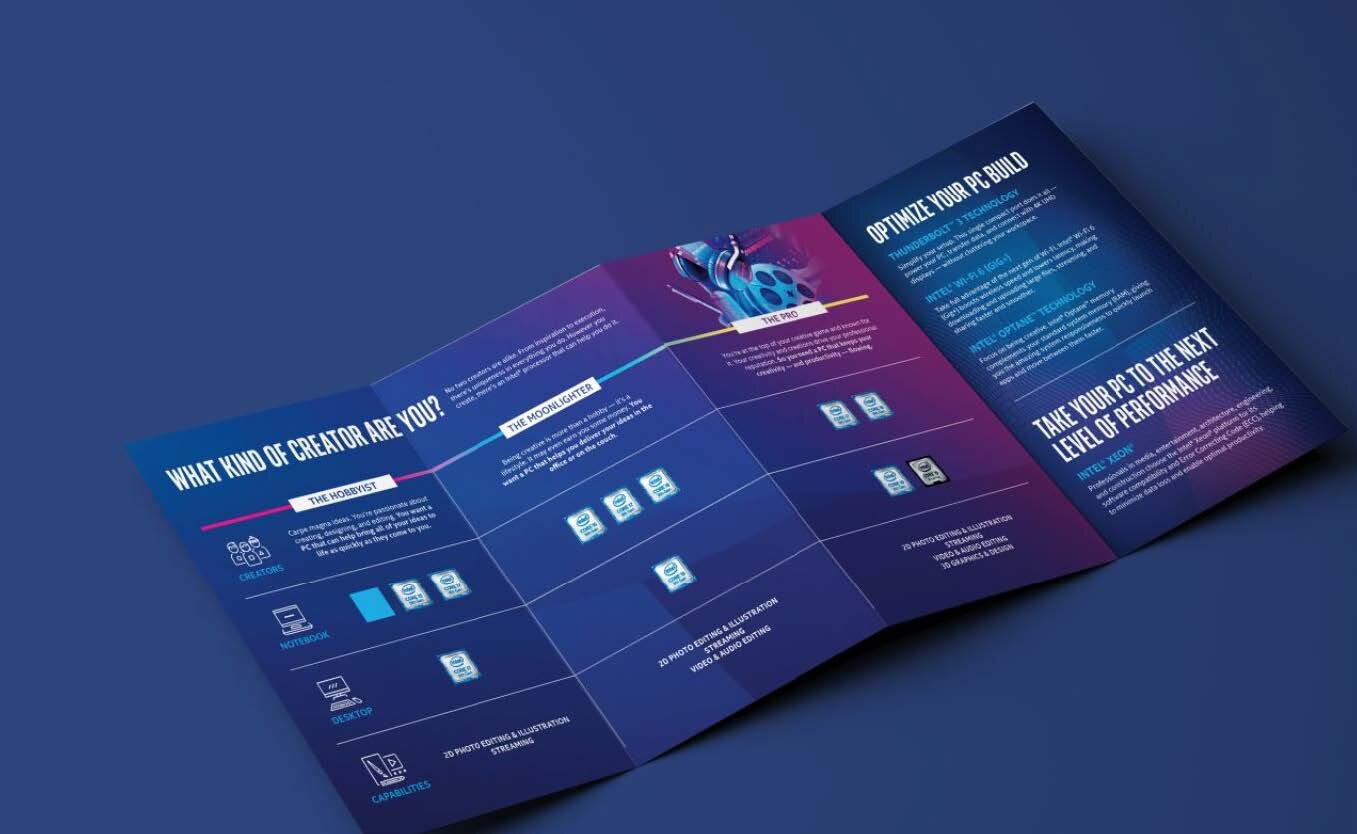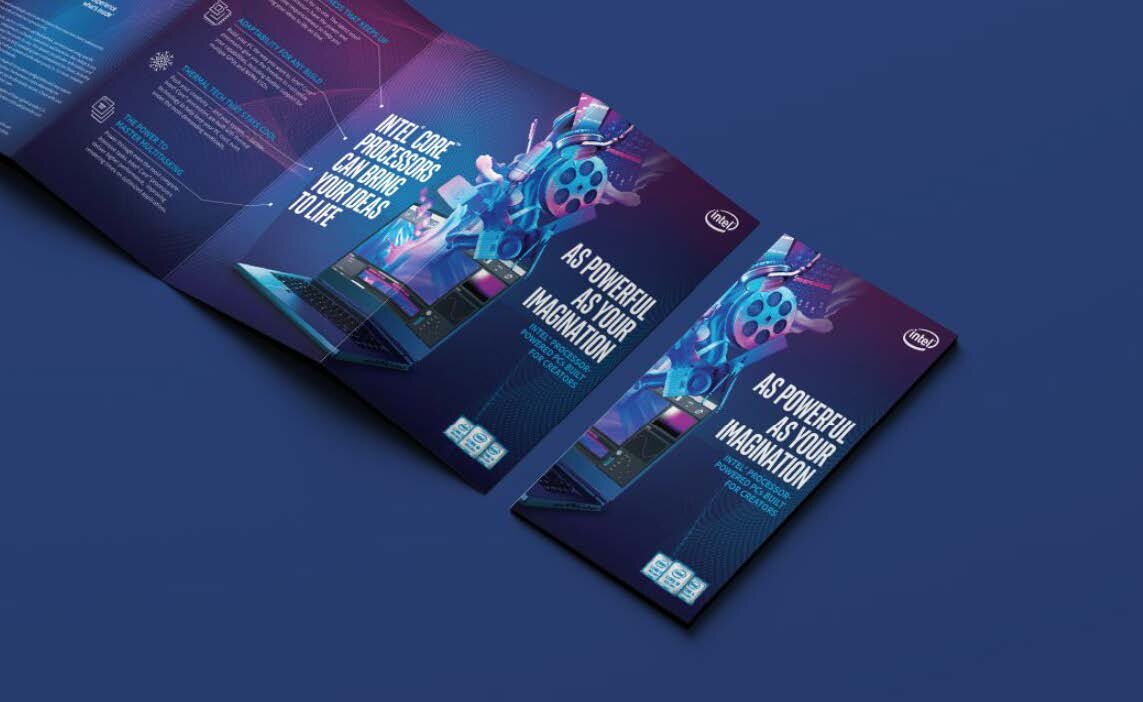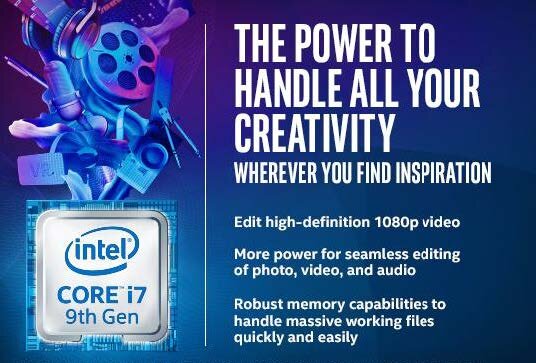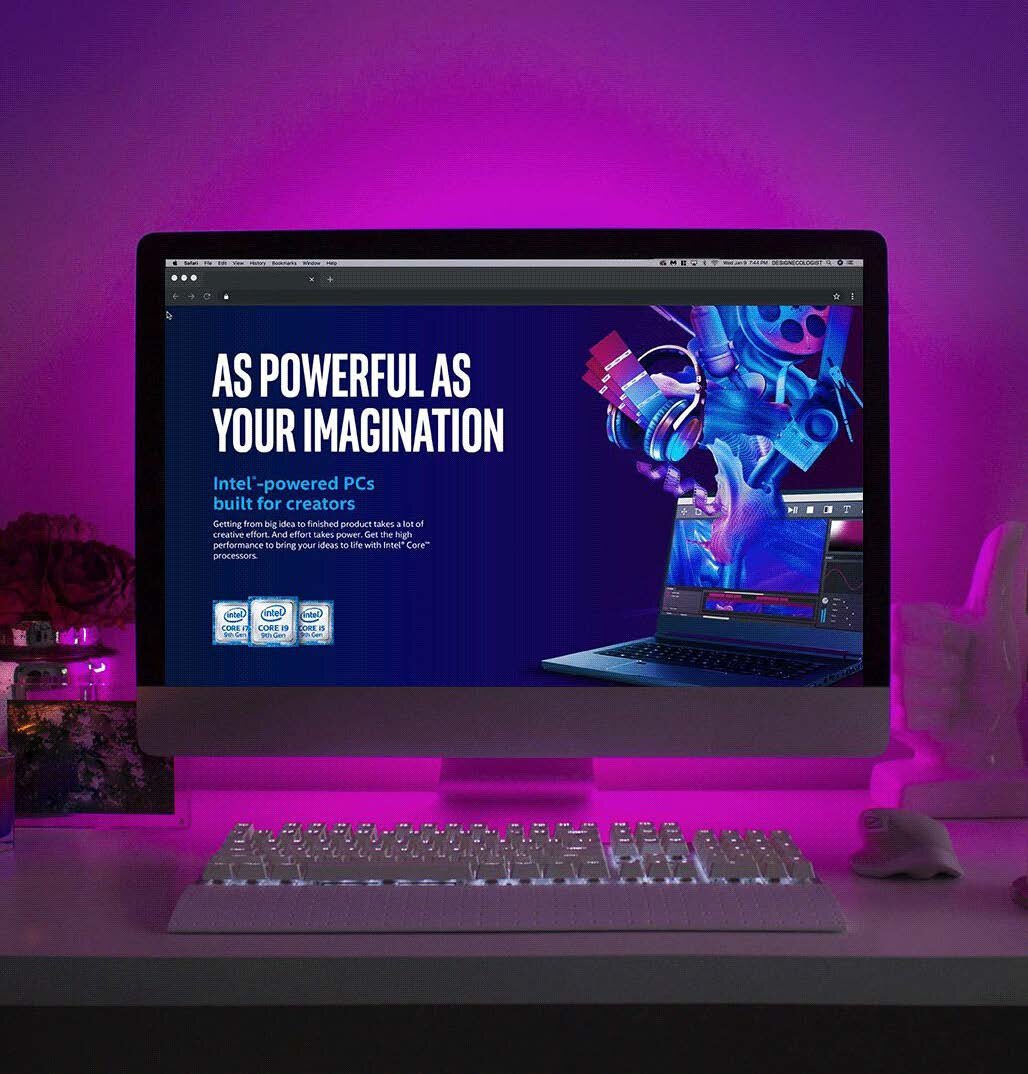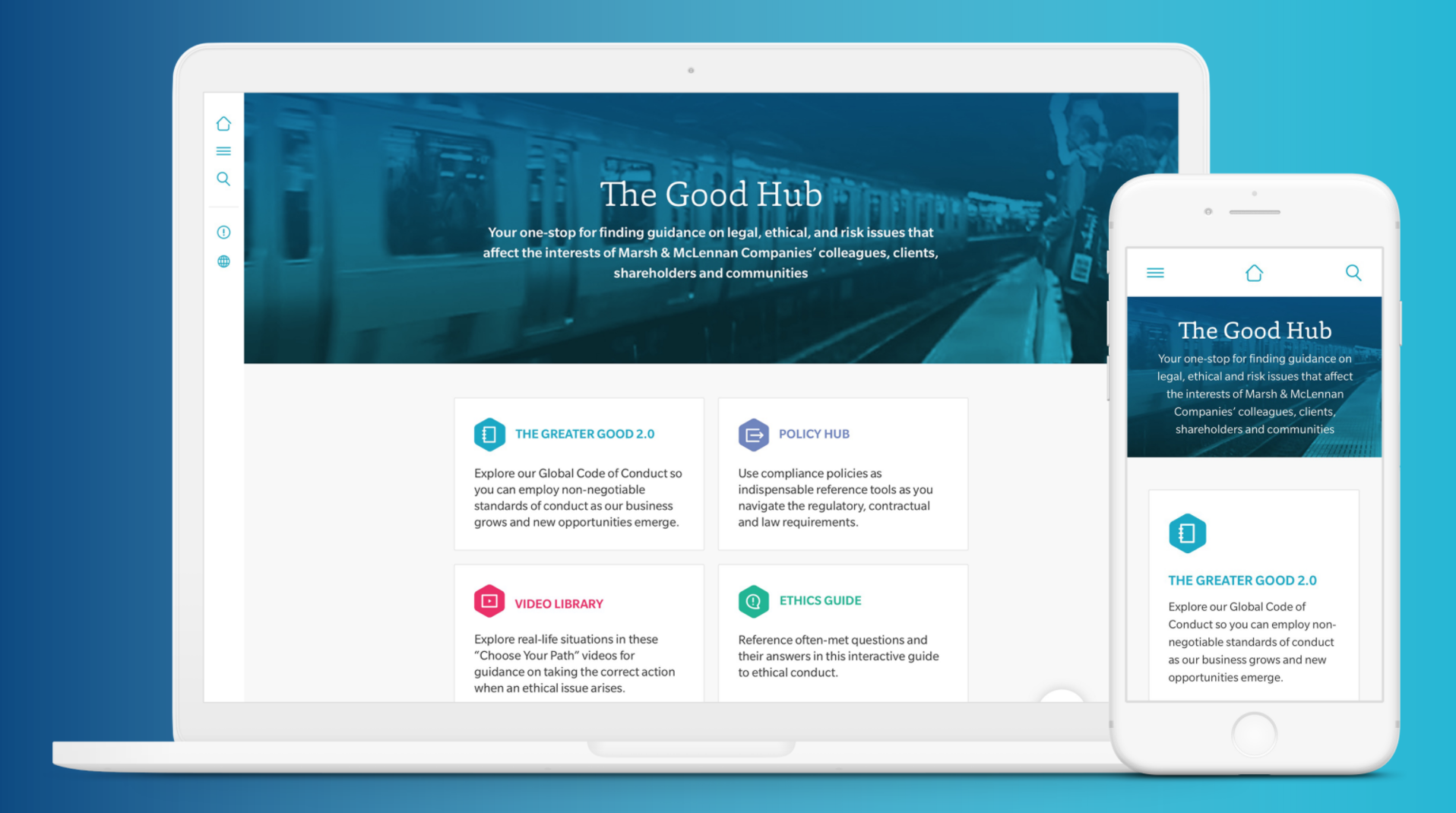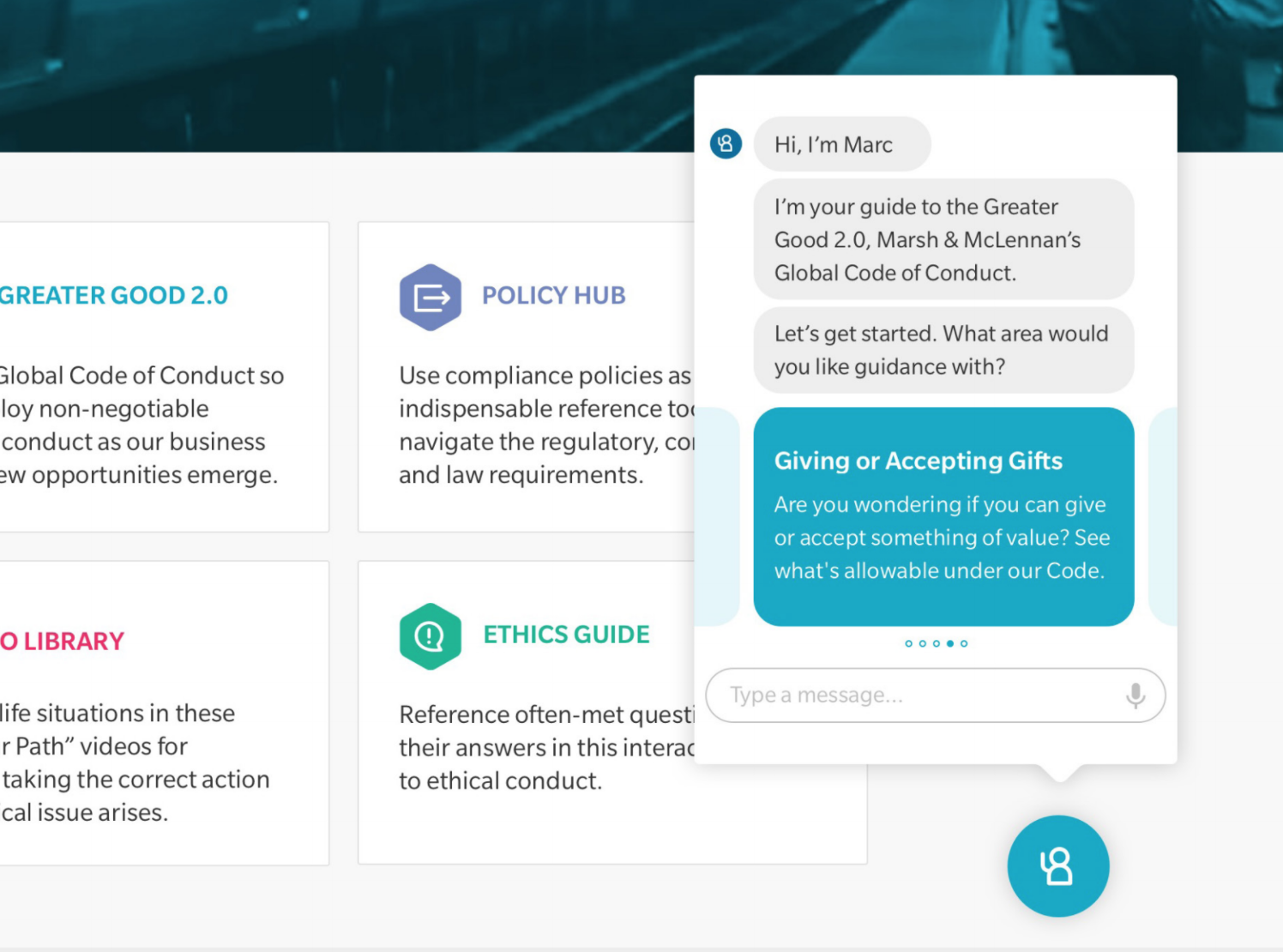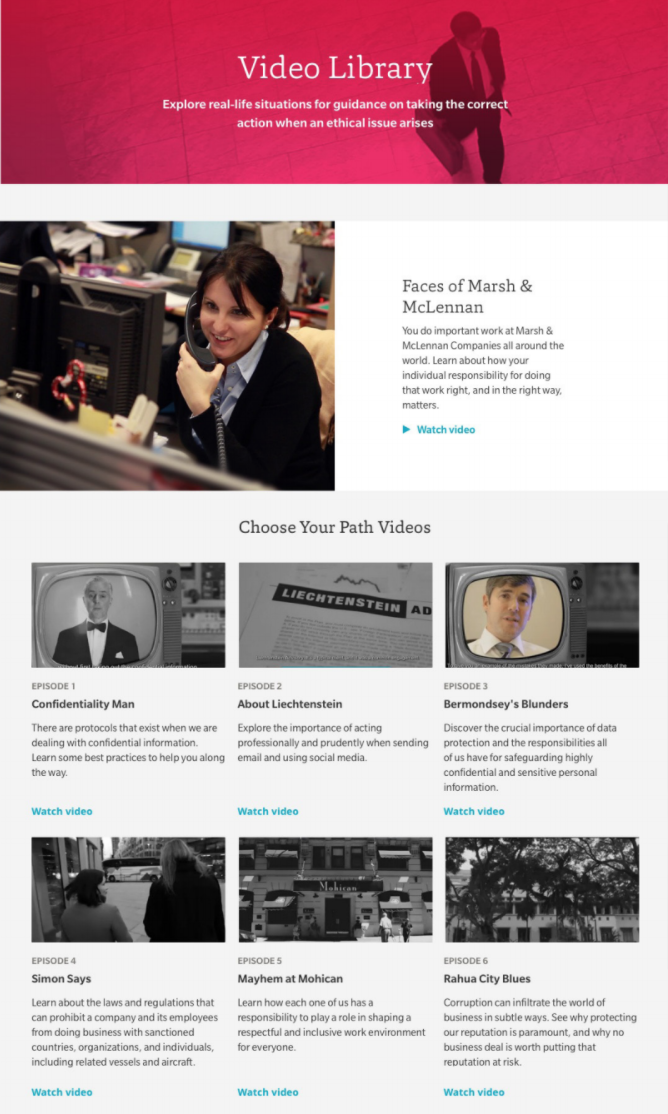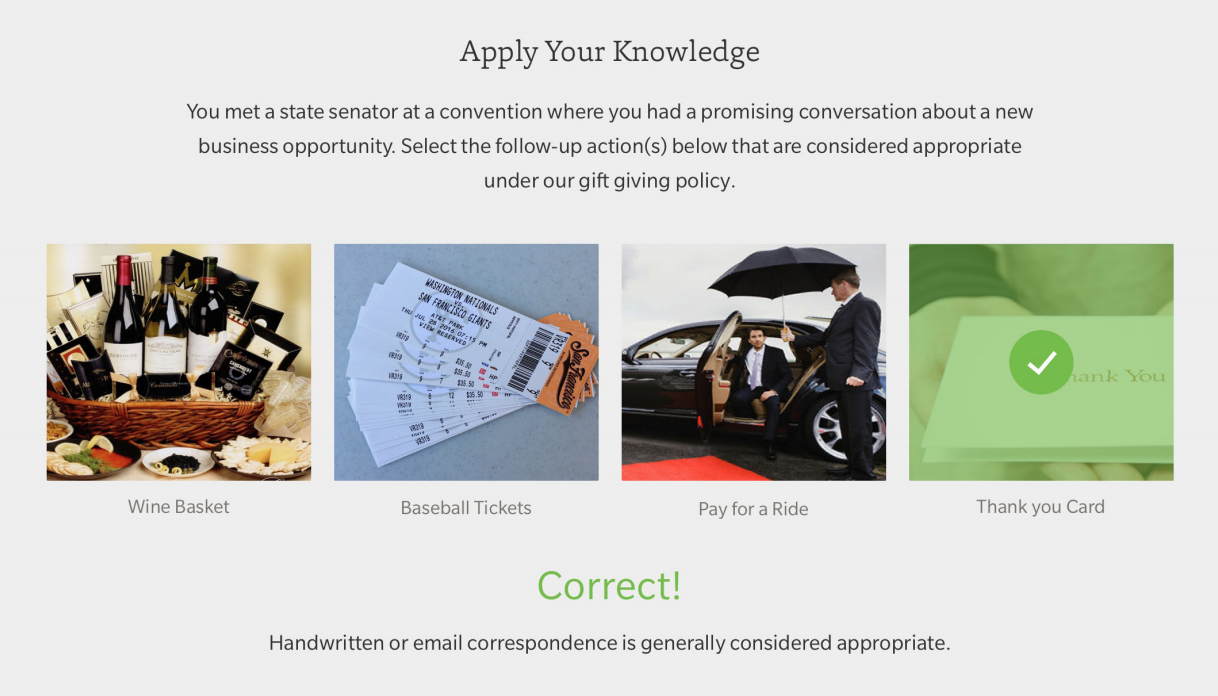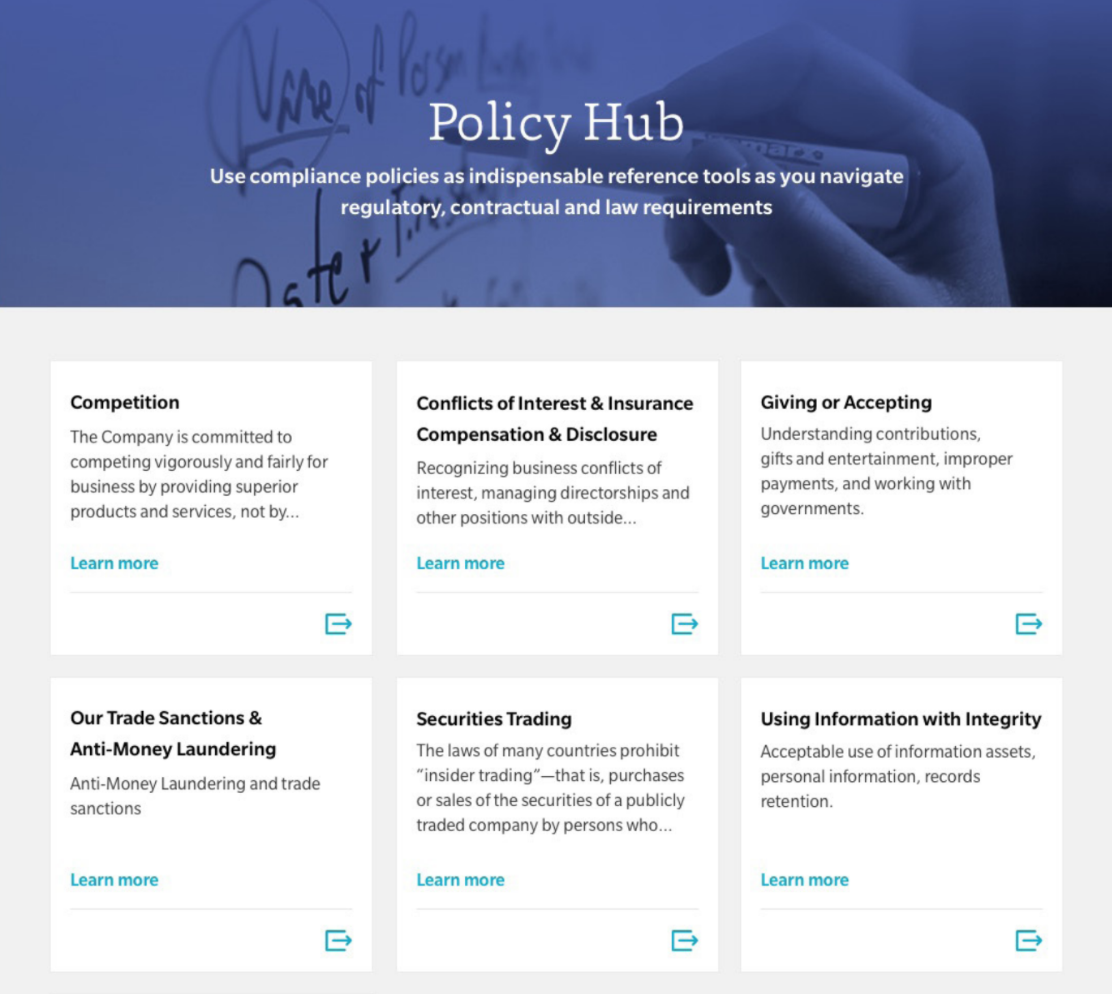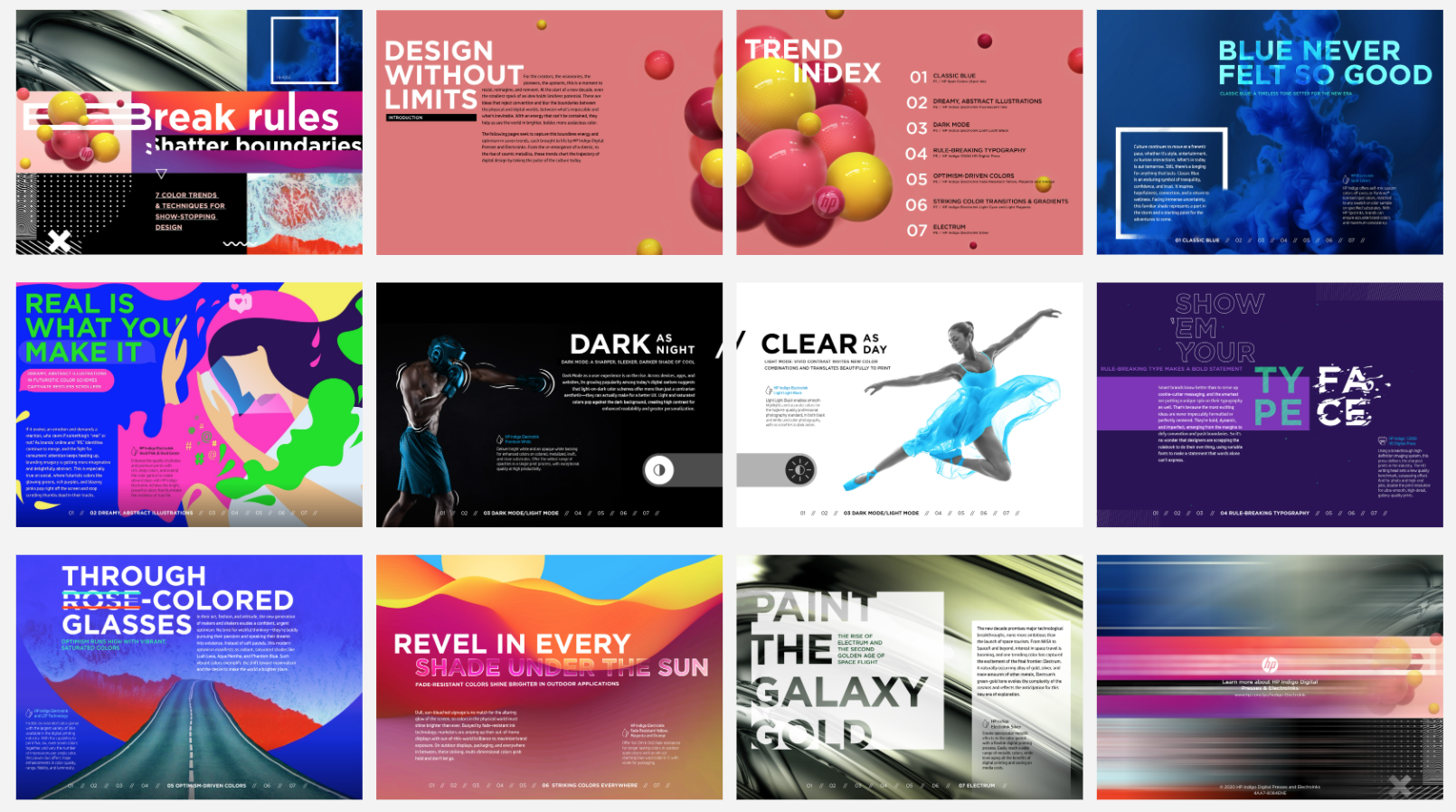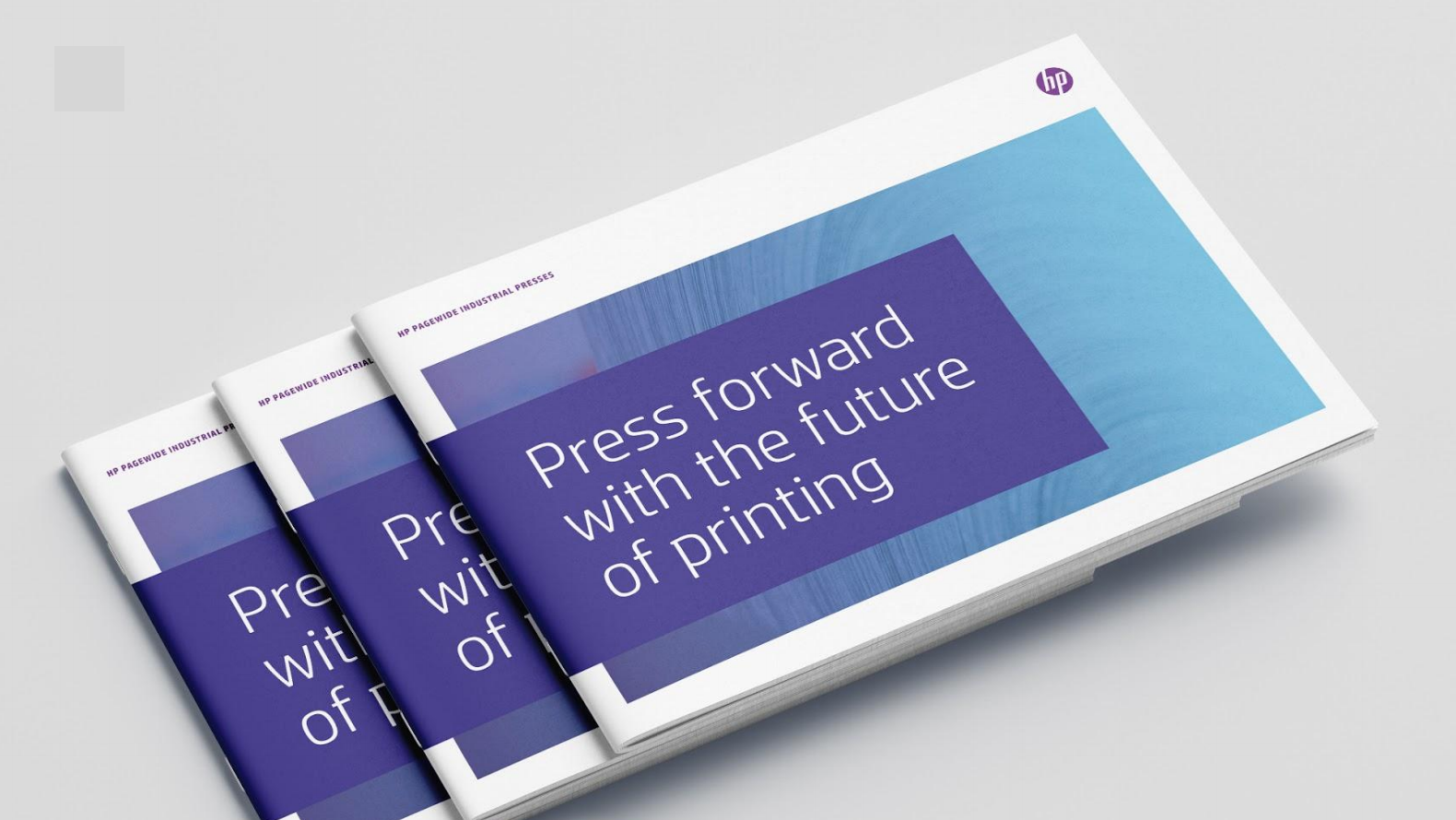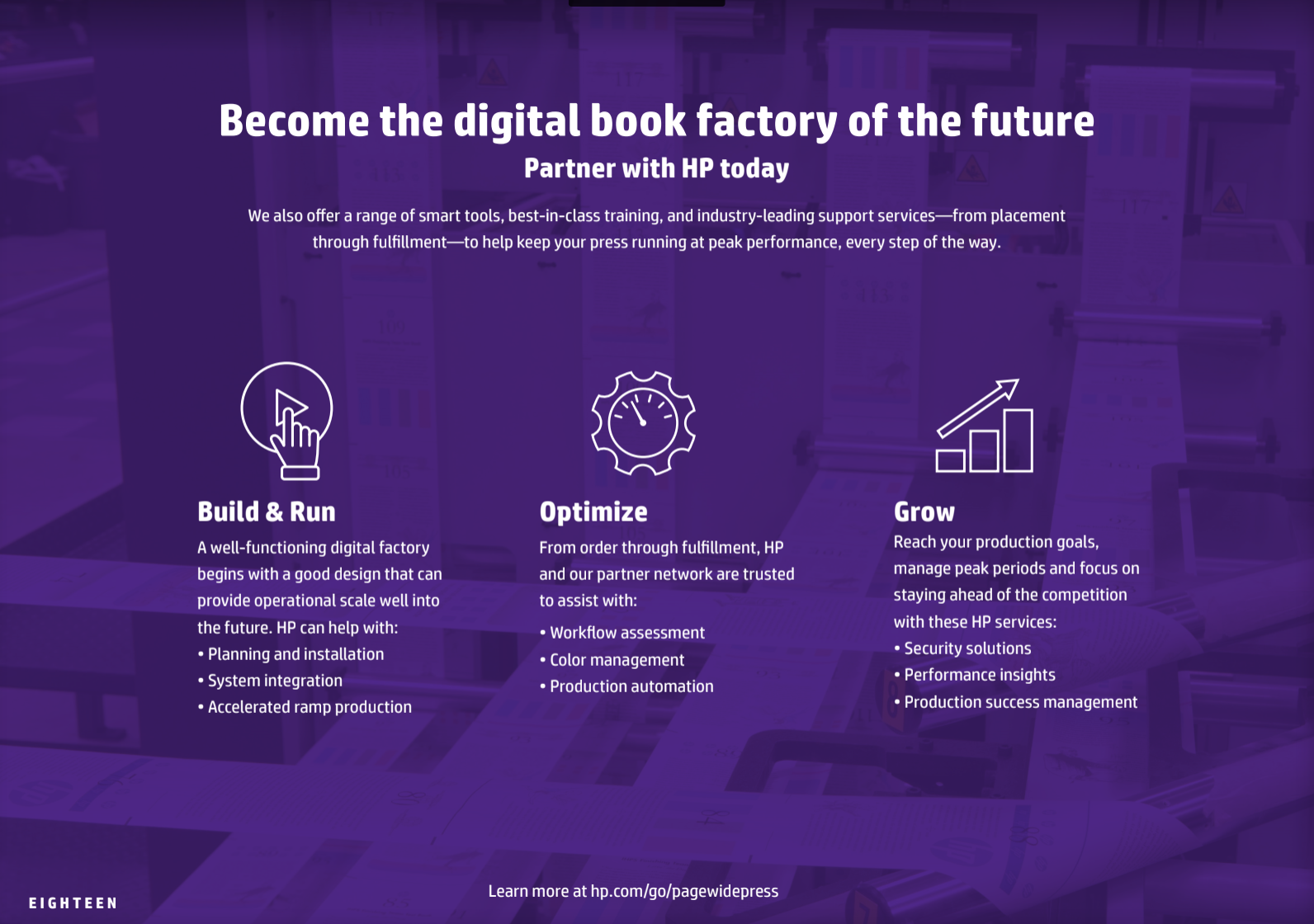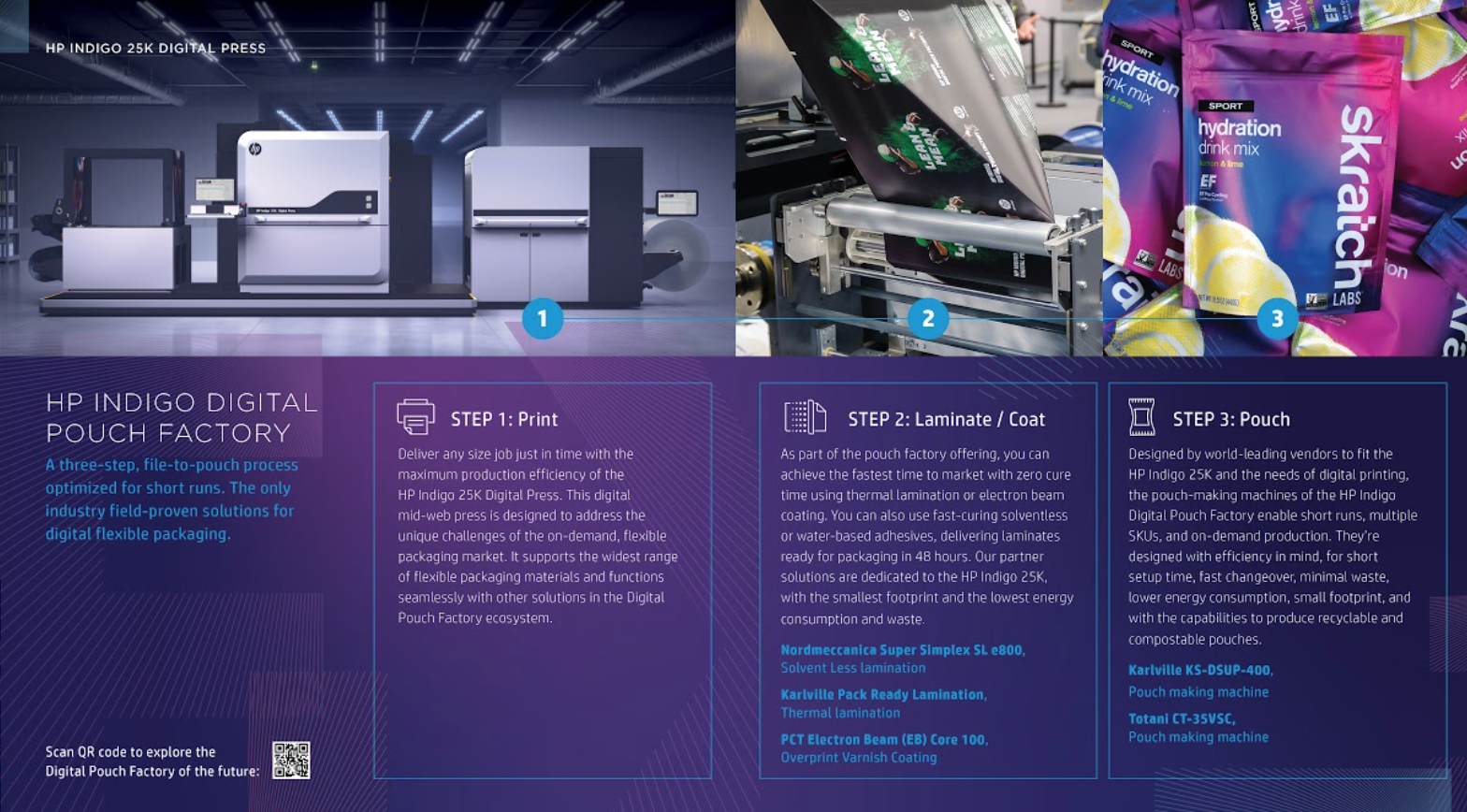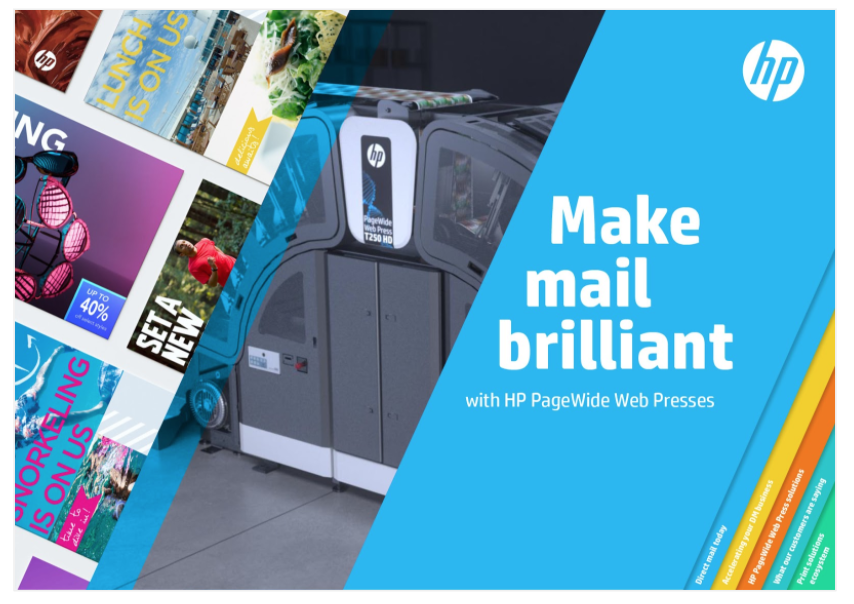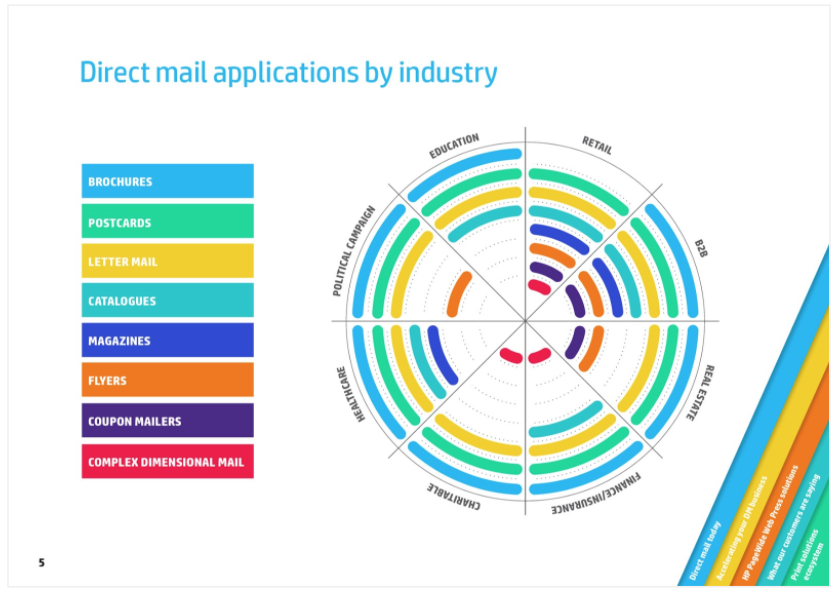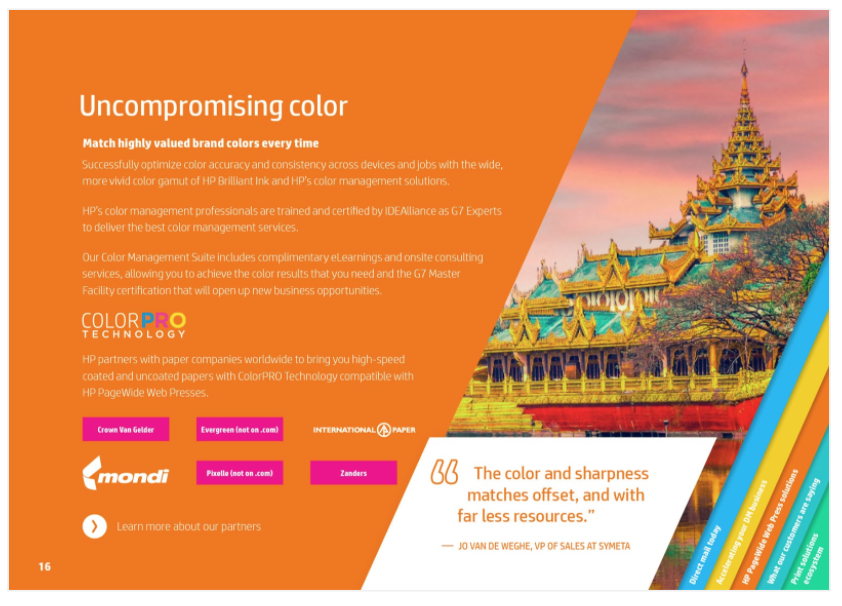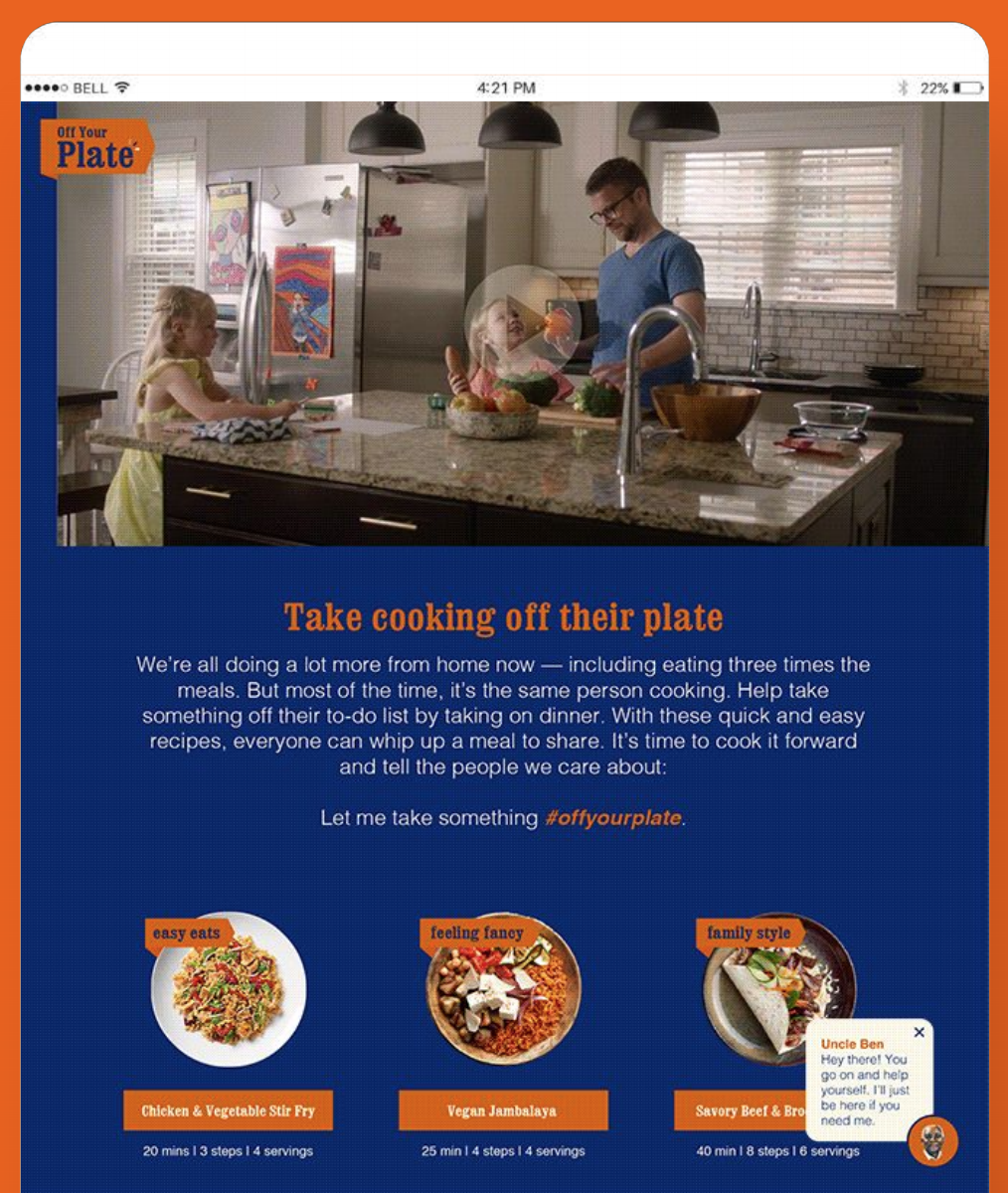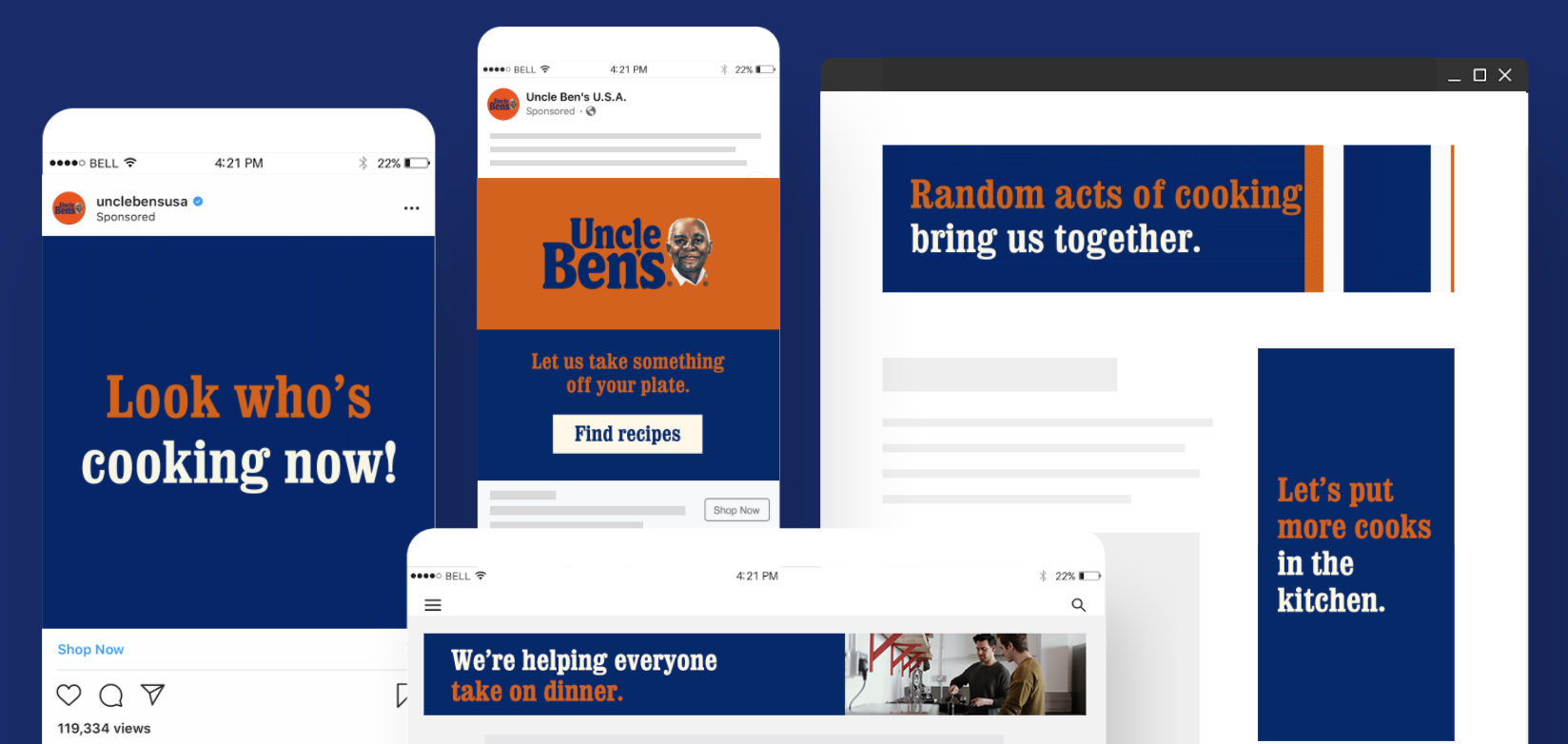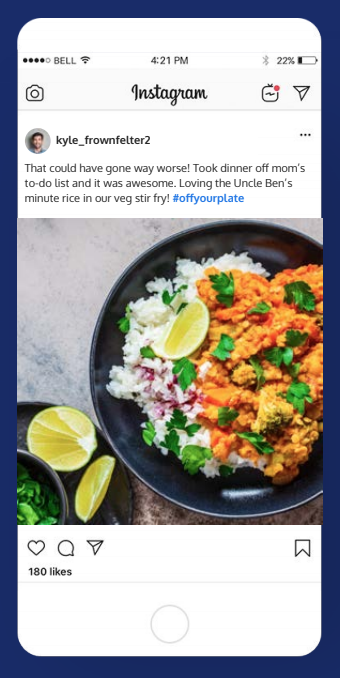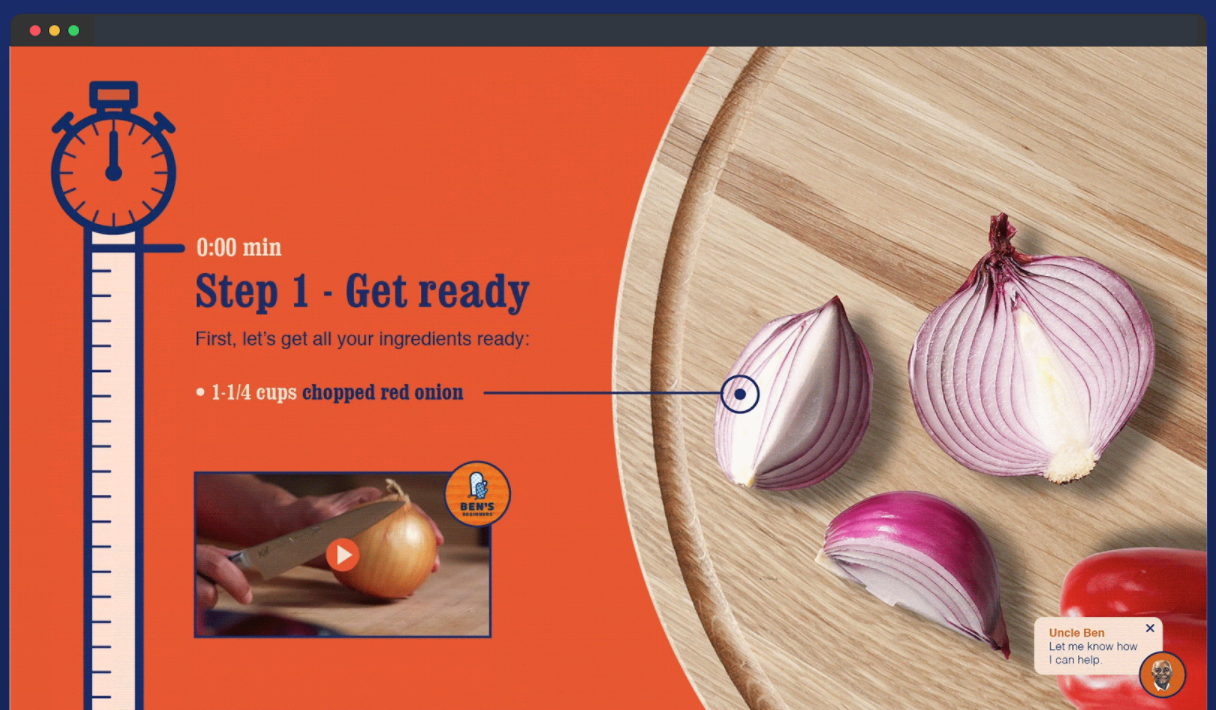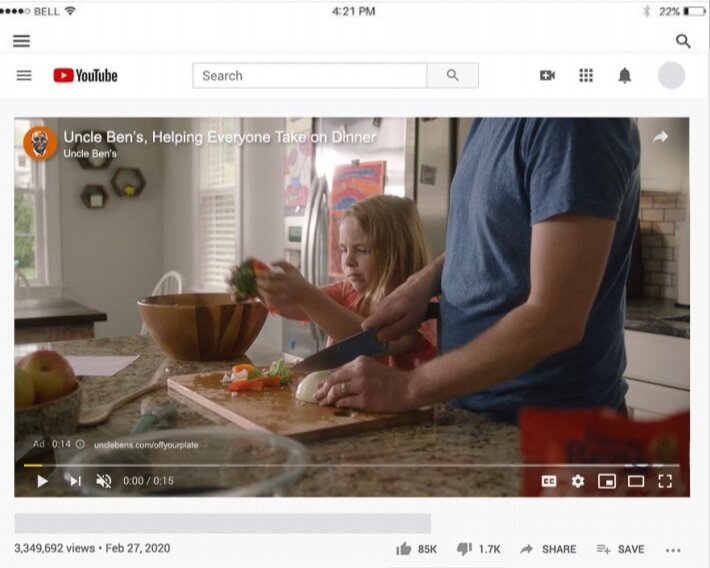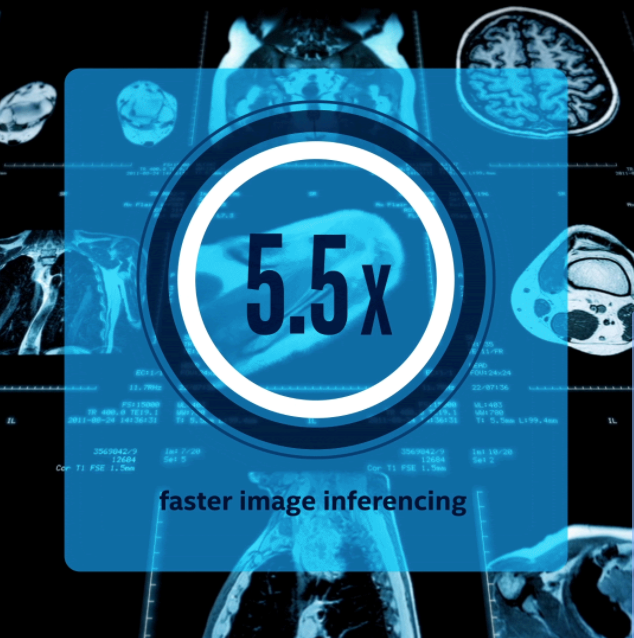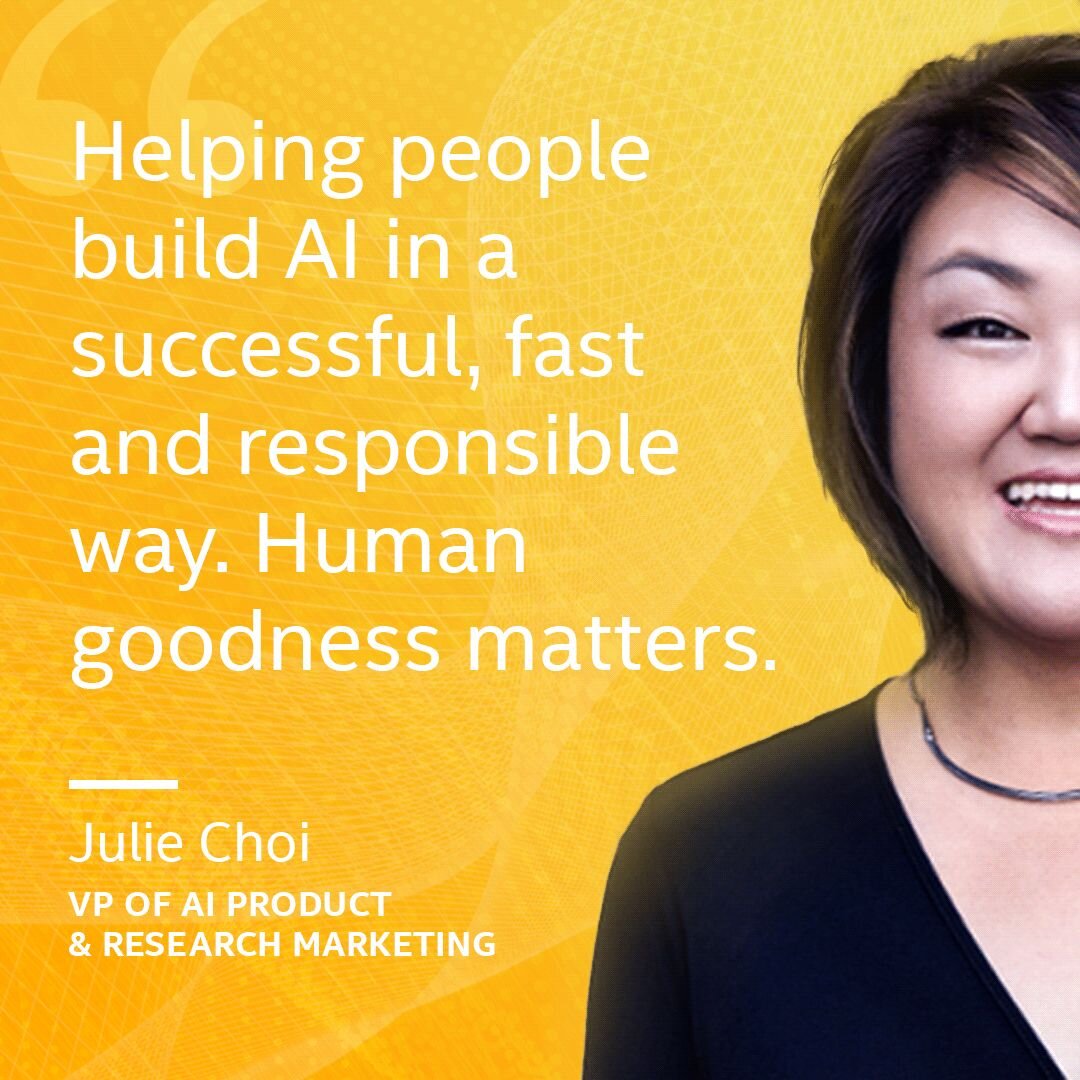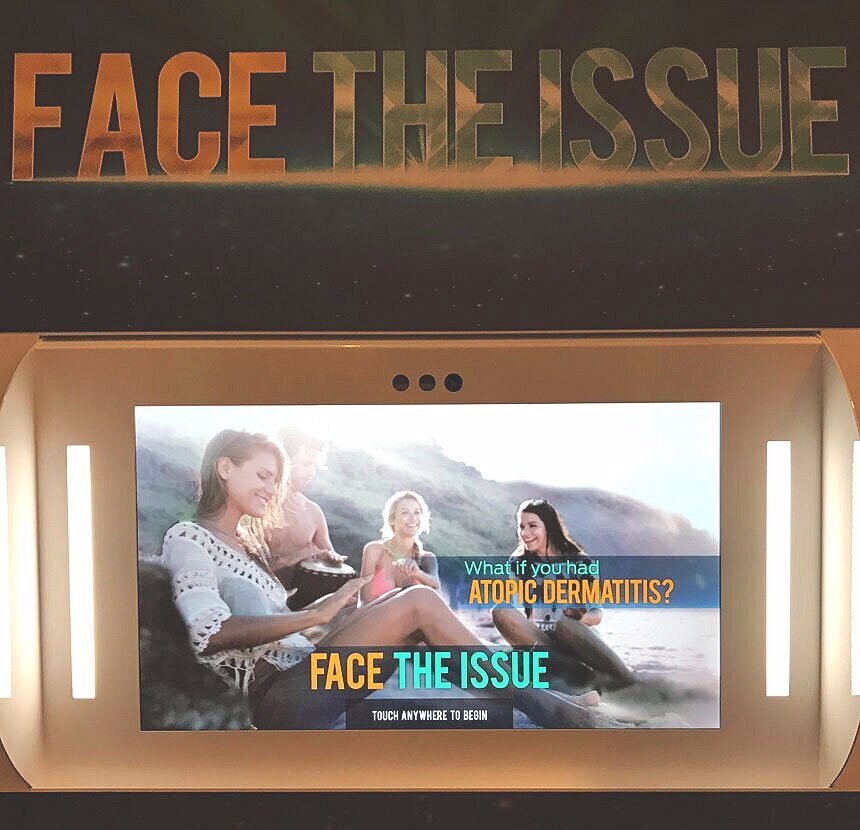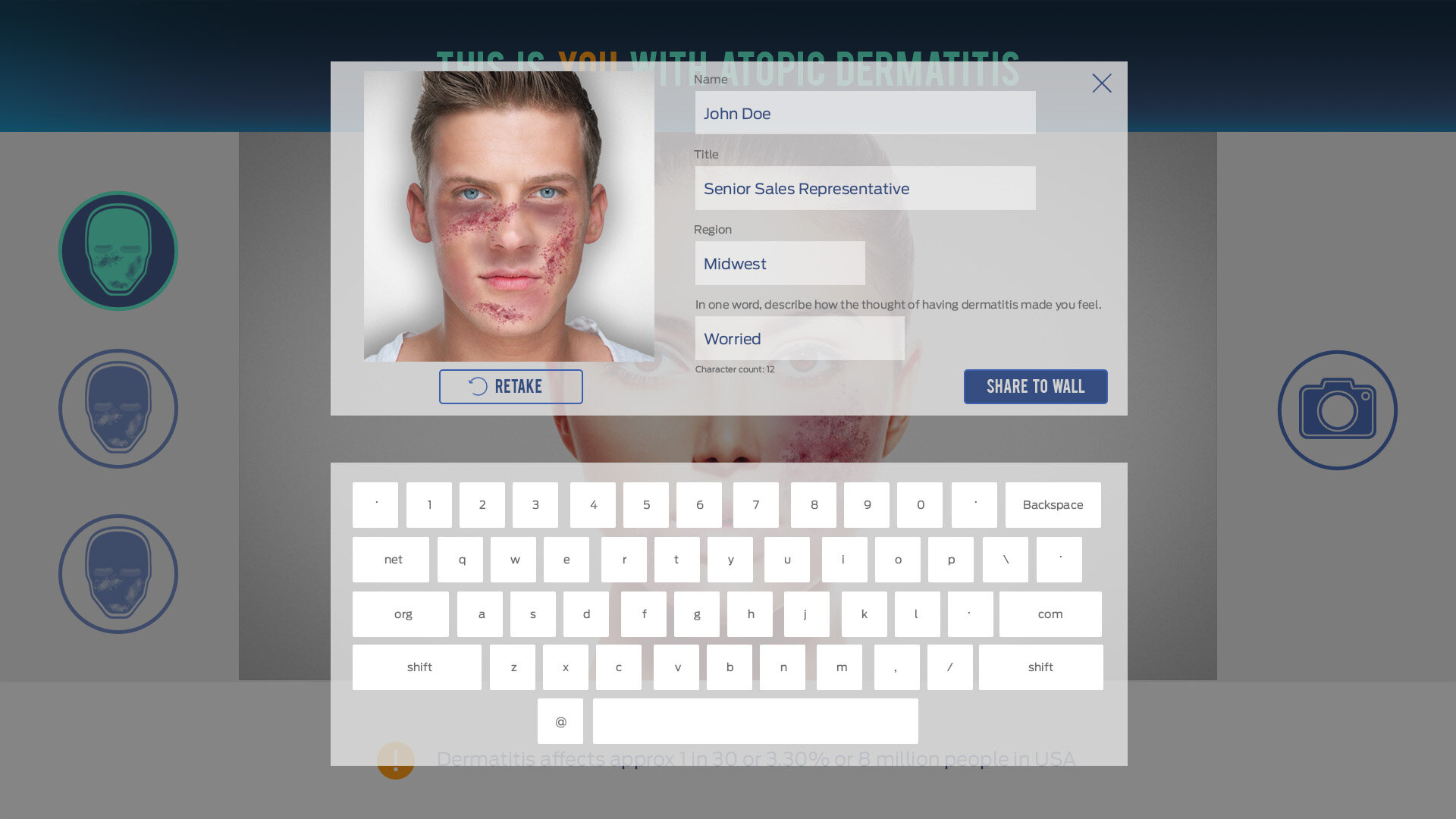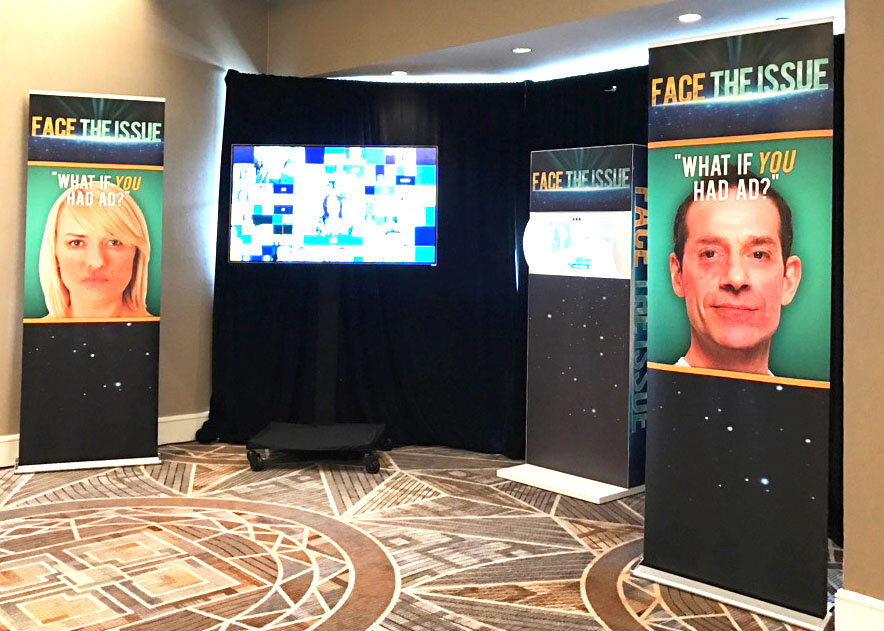INTEL // CREATOR PC CAMPAIGN
To drive customer consideration for Intel-based PCs purpose-built for creative applications, our project team concepted and designed a set of assets for Intel’s channel and retail partners. Inspired by the creative processes and thought leadership from Adobe and Apple, I hosted an internal workshop with our creative team to brainstorm and ensure the ideas would effectively speak to our audience. The messaging, informational content, and key visuals had to appeal to artists and makers by showcasing the PCs’ powerful performance and convenient portability. The technical specs had to be digestible and relatable so the audience could clearly understand which processor type would cater to their creative needs. On the campaign landing page, I developed an interactive tool for users to “choose your own adventure,” allowing them to explore product features and use cases in a more personalized way. The creative team did an outstanding job capturing the essence of the product capabilities by concepting an eye-catching, dream-like visual style that employed 3D rendering and animation. We then translated the digital banner ads and web experience to print ads and a brochure. Intel’s partners eagerly leveraged the campaign assets to stand out in the market and capture customer attention.
Marsh & McLennan // DIGITAL CODE OF CONDUCT
Marsh & McLennan Companies, a global professional services firm, approached our agency looking to overhaul their current code of business conduct. They wanted a modern, digital experience that would better educate their employees, partners, and vendors. After auditing the code content, I interviewed several stakeholders (associates, managers, and legal advisors) from each of MMC’s operating companies to better understand each topic or section within the code, digging into the business challenges and potential risk an employee might encounter during their tenure at the company. We discussed responses and alternatives that would set employees up for success and risk mitigation in the event of a compromising situation. Armed with a wealth of new insights, I tackled the entire code of conduct, organizing the experience into logical, easy-to-digest chapters with knowledge checkpoints and activities to break up the heavier content and encourage knowledge retention. Interactive content included basic quizzes, true/false questions, matching cards, videos, do’s and don’t’s, and FAQs. On the backend, I worked with our development team to incorporate engagement tracking, allowing managers and training facilitators to understand opportunities for additional learning. Analytics would also allow our team to pinpoint areas for UX and content improvements. With approval on the new format, I then moved into building an interactive chatbot for the code of business conduct site. Many of MMC’s employees travel and work with third-parties, so they require a simple resource for locating answers before finding themselves in any sort of pickle. The chatbot would serve as that tool to quickly access specific guidelines within the code, for exploring options when encountering questionable situations, and for finding the right channel to report an incident. I worked closely with our developers to build a natural language processing component to help speed the chat process wherein users could easily type in keywords to find what they needed. Otherwise, the chatbot followed a conversational flow that presented some of the most common topics and scenarios through use of buttons. We launched the new site with a full campaign of internal assets, including emails, banners, print materials to hang around the offices, and collateral to support training facilitators. The client could not have been happier, and this project won a Horizon Interactive Bronze Award for Training / E-Learning Website. What an honor!
HP // INDUSTRIAL PRINT PRESS BROCHURES
HP’s Industrial Print business unit was gearing up to introduce their new HP Pagewide T250 web press to market. This versatile printing press can be used in various industrial print segments, including publishing, direct mail, and packaging. However, previous approaches to marketing assets hardly distinguished between segments, often utilizing a single brochure and missing the mark on addressing nuance among use cases. This time the client wanted to ensure stronger audience targeting by creating separate brochures and assets per segment. First, the creative team and I refreshed their annual design trends ebook. This piece typically serves as HP thought leadership in the broad industrial print space. I researched emerging trends in print, graphic design, web design, and branding to bring together a collection of trends that would put HP at the forefront of innovative design thought leadership. I then tied HP’s unique ink, substrate, and finishing solutions to each trend so the audience would understand how HP’s industrial presses would help achieve the latest and greatest in design, often enabling them to take on new business. The final result was a beautiful cross between a brochure and a coffee table book. And then for the three segment-specific brochures, I explored the different market trends, customer needs, and cost considerations to create a unique print story for each segment. I also included press specs, performance stats, customer case studies, and feature highlights to provide a comprehensive and valuable understanding to potential customers — just enough to hook their attention and nudge them toward connecting with a sales rep. Each of these brochures proved perfect examples of how amazing ideas stem from the right balance of content strategy, creative ambition, and client trust.
BEN’S ORIGINAL // COVID-19 RESPONSE CAMPAIGN
Just months after the recent global pandemic hit the US, multinational consumer packaged goods brand, Mars Inc., enlisted our agency’s help in coming up with a more sustainable, phased marketing contingency plan for their Ben’s Original (formerly Uncle Ben’s) rice brand. Consumer behavior, especially when it came to grocery shopping, had changed overnight. And while rice sales thrived, Ben’s Original was not breaking into any new buyer segments. As I combed through the wealth of Covid-19 consumer data and emerging trends, one insight kept presenting itself: the primary home chefs of households were experiencing cooking fatigue. I pulled together a short survey and had it translated to several other languages so that we could gather a few more nuggets of information and confirm home chefs around the world were also experiencing the same fatigue.
Armed with fresh data and insights, I came up with the idea to inspire friends and family to relieve the “hero cook” by taking meal preparation “off their plate” — sort of a pay-it-forward moment. And they could lean on Ben’s Original rice as a quick and easy way to contribute to that meal. The campaign strategy followed three key communication goals: spark the conversation, inspire the habit, and feed the movement. The campaign would begin with viral videos from celebrity spokespeople inviting consumers to make a meal for a loved one. Tactics then expanded to a TV spot, dynamic social and display ads targeted and personalized for the different audience segments, print ads, a campaign landing page with interactive recipe guides and user-generated social content, Youtube ad pre-roll, Pinterest recipes, and Amazon shopper assets. And most of these tactics would be transcreated for the target global markets. This campaign approach aimed to bring value to people through new habit formation, to recruit new users, to tap into the brand’s DNA and role of making everyday cooking easier, and to offer personalization and data optimization throughout the customer journey.
Amidst developing the final campaign plan and creative, Mars Inc. paused the work as the George Floyd tragedy and protests encouraged them to explore rebranding. The campaign did not see the light of day, but the process and experience felt like a huge win for our team who worked so hard under remote conditions and definitely leaned on Ben’s Original for a meal or two along the way.
INTEL // @INTELIOT ALWAYS-ON SOCIAL CONTENT
As the social media agency of record for Intel’s Internet of Things (IoT) group, our lean, yet mighty, team of strategy (me!) and creative was tasked with rolling out a new approach for always-on social content. The content needed to be both timely and relevant in order to convey how Intel IoT was at the forefront of intelligent innovation and how Intel technologies would empower customers to modernize their business. Based on social listening, B2B social best practices, and an audit of other technology brands and competitors on social, I wrote a comprehensive playbook for content strategy, voice and tone, posting cadence, benchmarking, the whole enchilada — across key channels: Twitter, LinkedIn, Facebook, and Instagram. The creative minds then swooped in to design a fresh look and feel for different types of posts to strengthen the Intel IoT brand identity. We pitched original ideas for thought leadership, event coverage, and customer success stories that we were then able to shoot and produce. And by the end of 2020, organic engagement of IoT social content reached 3.6%, a 57% increase from Q1 2020. I don’t say this lightly, but sourcing story ideas and bringing them to life on social was an honest blast.
REGENERON // ATOPIC DERMATITIS AR KIOSK
Regeneron, a US-based biotechnology innovator, was looking for an engaging way to educate their sales and marketing teams about the skin disease, atopic dermatitis, as the company was preparing to launch a new treatment for the condition. Utilizing cross-collaboration with subject matter experts and a third-party developer, our team designed an augmented reality (AR) experience with photo capturing capabilities that would live on a kiosk at an internal training conference. This AR experience uses Intel RealSense Technology to map the user’s face on a kiosk screen and illustrate upon it the visible symptoms of atopic dermatitis. Through this experience, users are able to see how various stages of the disease could manifest on their own faces and then are given a moment to reflect and respond to the emotions they may be feeling on a short, on-screen form. This powerful connection to the patient and the disease state is a necessary part of training in the world of biotechnology. Following the live training event, the photos and text reactions captured at the kiosk were used in pull-through internal communications. Though the subject matter was of a more sobering nature, this project yielded high praise from the client, so much so, that the AR kiosk now holds a permanent home at the client’s headquarters.

